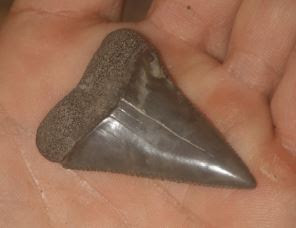 |
| Rhino or Teleoceras Skull Cap Fossil |
I decided to show a different kind of Treasure Coast find today. I often tell you to keep your eyes open when you metal detect. You can find different types of things - some of them being really old. One example would be fossils.
I think the fossil shown above is my favorite Treasure Coast fossil fins. A real fossil expert told me it was a rhino or teleoceras skull cap from the Miocene period (25 - 5 million years ago). I had no clue what type of animal it came from but got an expert and friend of this blog to identify it for me.
I guess I like that one best simply because I find it difficult to think of anything like a rhinoceros being in Florida.
I think most detectorist like to find old things, but we are usually thinking in terms of maybe hundreds of years rather than millions of years.
 |
Fossil Great White Shark Tooth.
|
A lot of people like shark teeth, and fossilized shark teeth are fairly common on some Treasure Coast beaches. This one was found on the banks of the Indian River. I wasn't fossil hunting when I found it. In fact when I first saw it I thought it was a piece of glass. And it is in very nice condition.
Below are a few more examples.
 |
| Camel Phalange Fossil. |
If you are like me, you don't readily think of camels being on the Treasure Coast either, but above is what I'm told is a fossilized camel phalange.
Below are a few more examples.
 |
| Whale Inner Ear Bone. |
 |
| Alligator Scute. |
 |
Fossilized Ivory From Mammoth or Mastadon.
|
I once saw a nice section of a tusk sticking out of the Treasure Coast sand.
 |
| Fossil Bone With Shark Teeth Marks. |
Some fossils will show something a little extra. Maybe it shows that it was worked by man or perhaps another animal left its mark like the bone shown above, which shows what appears to be teeth marks.
Keep your eyes open while metal detecting. You might see something older or more interesting than what you were looking for.
I'll add one tip here. It goes along with the mistakes I've been talking about in some of my previous posts. Label your finds with as much as you know about the identity of the item and also the place and details of the find. You might think that you'll remember all about it, but time takes its toll. As you can see from the above photos, I had some of these labeled, and I am glad of that. Some were not labeled. That is a mistake I made a lot. Don't put it off. You might remember the details for some finds, but you might regret forgetting the details of others.
 |
| Fossil Hoof. |
You might be interested in the history of horses in North America. If so here is a link.
https://www.statelinetack.com/content/general-information/the-prehistoric-horses-of-north-america/
Horses changed a lot over the millions of years.
Horse teeth fossils are very common finds on the Treasure Coast, as are turtle scutes.
Bison, deer, peccary, sloth, snake, fish, wolf, bivalve and mollusk, coral, crab and wood fossils are some of the others fossils that have been found on the Treasure Coast.
If you are interested in finding fossils and haven't done it before, I'd recommend paying a professional guide to take you for a day trip to the Peace River. It is worth the money, and you'll learn a lot. I did it once several years ago.
---
The surf is going to be around two feet today, and the tides are now small.
Happy hunting,
TreasureGuide@comcast.net
